SBVS191B April 2012 – August 2014
PRODUCTION DATA.
- 1 Features
- 2 Applications
- 3 Description
- 4 Revision History
- 5 Pin Configuration and Functions
- 6 Specifications
- 7 Detailed Description
- 8 Application and Implementation
- 9 Power-Supply Recommendations
- 10Layout
- 11Device and Documentation Support
- 12Mechanical, Packaging, and Orderable Information
パッケージ・オプション
デバイスごとのパッケージ図は、PDF版データシートをご参照ください。
メカニカル・データ(パッケージ|ピン)
- YZY|5
サーマルパッド・メカニカル・データ
発注情報
6 Specifications
6.1 Absolute Maximum Ratings
over operating junction temperature range (unless otherwise noted)(1)| MIN | MAX | UNIT | ||
|---|---|---|---|---|
| Voltage(2) | IN | –0.3 | 7.0 | V |
| EN | –0.3 | VIN + 0.3 | V | |
| OUT | –0.3 | VIN + 0.3 | V | |
| Current | OUT | Internally limited | mA | |
| Temperature | Operating virtual junction, TJ | –55 | 150 | °C |
(1) Stresses beyond those listed under Absolute Maximum Ratings may cause permanent damage to the device. These are stress ratings only, which do not imply functional operation of the device at these or any other conditions beyond those indicated under Recommended Operating Conditions. Exposure to absolute-maximum-rated conditions for extended periods may affect device reliability.
(2) All voltages are with respect to network ground terminal.
6.2 Handling Ratings
| MIN | MAX | UNIT | |||
|---|---|---|---|---|---|
| Tstg | Storage temperature range | –55 | 150 | °C | |
| V(ESD) | Electrostatic discharge | Human body model (HBM), per ANSI/ESDA/JEDEC JS-001, all pins(1) | –2000 | 2000 | V |
| Charged device model (CDM), per JEDEC specification JESD22-C101, all pins(2) | –500 | 500 | |||
(1) JEDEC document JEP155 states that 500-V HBM allows safe manufacturing with a standard ESD control process.
(2) JEDEC document JEP157 states that 250-V CDM allows safe manufacturing with a standard ESD control process.
6.3 Recommended Operating Conditions
over operating junction temperature range (unless otherwise noted)| MIN | NOM | MAX | UNIT | ||
|---|---|---|---|---|---|
| VIN | Input voltage | 2.7 | 6.5 | V | |
| IOUT | Output current | 0.5 | 200 | mA | |
| TJ | Operating junction temperature | –40 | 125 | °C | |
6.4 Thermal Information
| THERMAL METRIC(1) | TPS799Lxx | UNIT | |
|---|---|---|---|
| YZY (DSBGA) | |||
| 5 PINS | |||
| RθJA | Junction-to-ambient thermal resistance | 143.3 | °C/W |
| RθJC(top) | Junction-to-case (top) thermal resistance | 1.1 | |
| RθJB | Junction-to-board thermal resistance | 84.7 | |
| ψJT | Junction-to-top characterization parameter | 3.8 | |
| ψJB | Junction-to-board characterization parameter | 84.4 | |
| RθJC(bot) | Junction-to-case (bottom) thermal resistance | N/A | |
(1) For more information about traditional and new thermal metrics, see the IC Package Thermal Metrics application report, SPRA953.
6.5 Electrical Characteristics
Over operating temperature range (TJ = –40°C to 125°C), VIN = VOUT(TYP) + 0.3 V or 2.7 V, whichever is greater; IOUT = 1 mA, VEN = VIN, COUT = 2.2 μF, CNR = 0.01 μF, unless otherwise noted. Typical values are at TJ = 25°C.| PARAMETER | TEST CONDITIONS | MIN | TYP | MAX | UNIT | ||
|---|---|---|---|---|---|---|---|
| VIN | Input voltage range(1) | 2.7 | 6.5 | V | |||
| VOUT | Output voltage range | 5.2 | 6.2 | V | |||
| Output accuracy, nominal | TJ = 25°C | –1.0% | 1.0% | ||||
| Output accuracy(1)
Over VIN, IOUT, temperature |
VOUT + 0.3 V ≤ VIN ≤ 6.5 V 500 μA ≤ IOUT ≤ 200 mA |
–2.0% | ±1.0% | 2.0% | |||
| ΔVO(ΔVI) | Line regulation(1) | VOUT(NOM) + 0.3 V ≤ VIN ≤ 6.5 V | 0.02 | %/V | |||
| ΔVO(ΔIO) | Load regulation | 500 μA ≤ IOUT ≤ 200 mA | 0.002 | %/mA | |||
| VDO | Dropout voltage (VIN = VOUT(NOM) – 0.1 V) |
VOUT ≥ 3.3 V, IOUT = 200 mA | 90 | 160 | mV | ||
| ILIM | Output current limit(2) | VOUT = 0.9 × VOUT(NOM) | 220 | 340 | 600 | mA | |
| IGND | Ground pin current | 500 μA ≤ IOUT ≤ 200 mA | 40 | 60 | μA | ||
| ISHDN | Shutdown current (IGND) | VEN ≤ 0.4 V, 2.7 V ≤ VIN ≤ 6.5 V | 0.15 | 1.0 | μA | ||
| PSRR | Power-supply rejection ratio | VIN = 6.5 V, VOUT = 2.85 V, CNR = 0.01 μF, IOUT = 100 mA |
f = 100 Hz | 70 | dB | ||
| f = 1 kHz | 66 | dB | |||||
| f = 10 kHz | 51 | dB | |||||
| f = 100 kHz | 38 | dB | |||||
| VN | Output noise voltage | BW = 10 Hz to 100 kHz | CNR = 0.01 μF | 10.5 × VOUT | μVRMS | ||
| CNR = none | 94 × VOUT | μVRMS | |||||
| Start-up time | VOUT = 5.7 V, RL = 28 Ω, COUT = 2.2 μF |
CNR = 0.01 μF | 90 | μs | |||
| CNR = none | 95 | μs | |||||
| VEN(HI) | Enable high (enabled) | 1.2 | VIN | V | |||
| VEN(LO) | Enable low (shutdown) | 0 | 0.4 | V | |||
| IEN(HI) | Enable pin current, enabled | VEN = VIN = 6.5 V | 0.03 | 1.0 | μA | ||
| Tsd | Thermal shutdown temperature | Shutdown, temperature increasing | 165 | °C | |||
| Reset, temperature decreasing | 145 | °C | |||||
| TJ | Operating junction temperature | –40 | 125 | °C | |||
| UVLO | Undervoltage lockout | VIN rising | 1.90 | 2.20 | 2.65 | V | |
| Hysteresis | VIN falling | 70 | mV | ||||
(1) Minimum VIN = VOUT + VDO or 2.7 V, whichever is greater.
(2) The TPS799Lxx has a peak current clamp during EN toggle start-up.
6.6 Typical Characteristics
Over operating temperature range (TJ= –40°C to 125°C), VIN = VOUT(TYP) + 0.3 V or 2.7 V, whichever is greater; IOUT = 1 mA, VEN = VIN, COUT = 2.2 μF, and CNR = 0.01μF, unless otherwise noted. Typical values are at TJ = 25°C.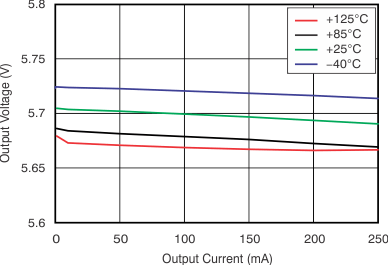
| VIN = 6.5 V |
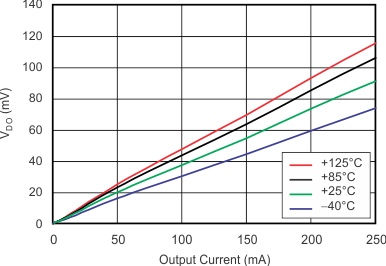
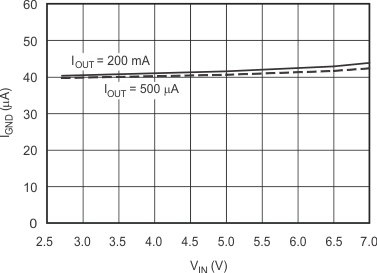
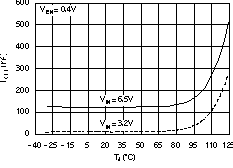
vs Junction Temperature
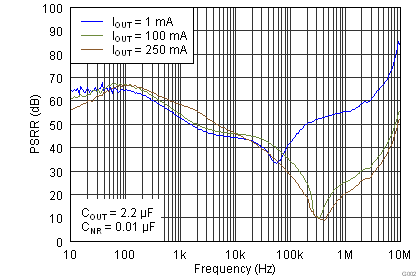
| VIN = 6.2 V | ||
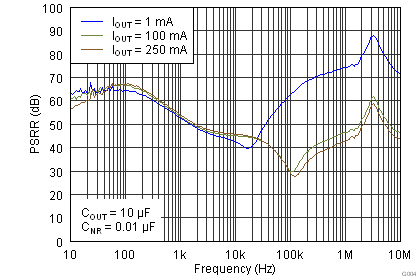
| VIN = 6.5 V |
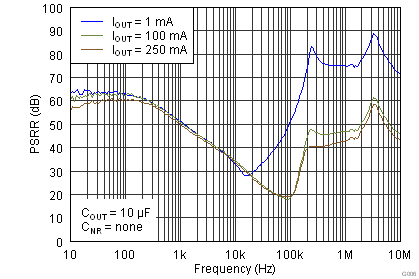
| VIN = 5.95 V |
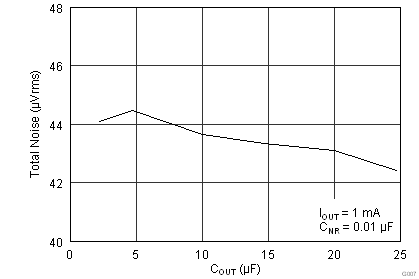
| VIN = 6 V |
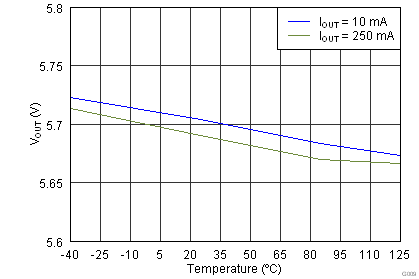
| TPS799Axx | ||
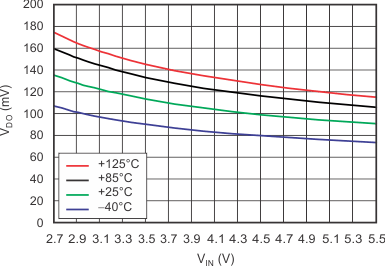
| IOUT = 250 mA |
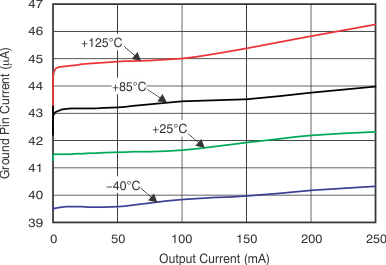
| VIN = 6.5 V |
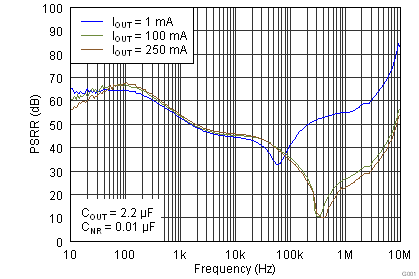
| VIN = 6.5 V | ||

| VIN = 5.95 V |
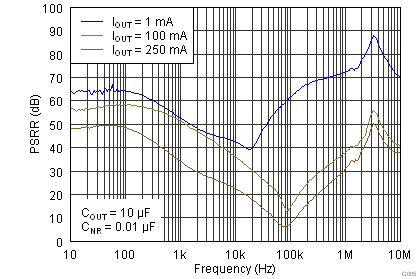
| VIN = 6.2 V |
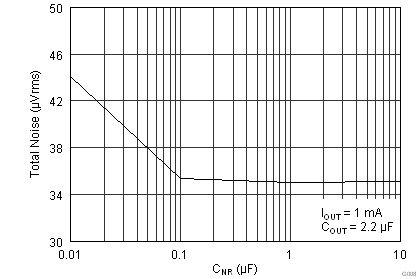
| VIN = 6 V |

| CIN = COUT = 20 µF | IOUT = 47 mA | |